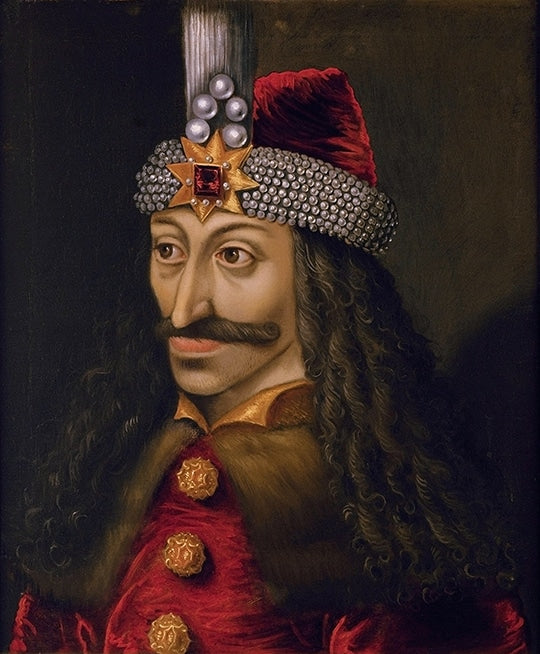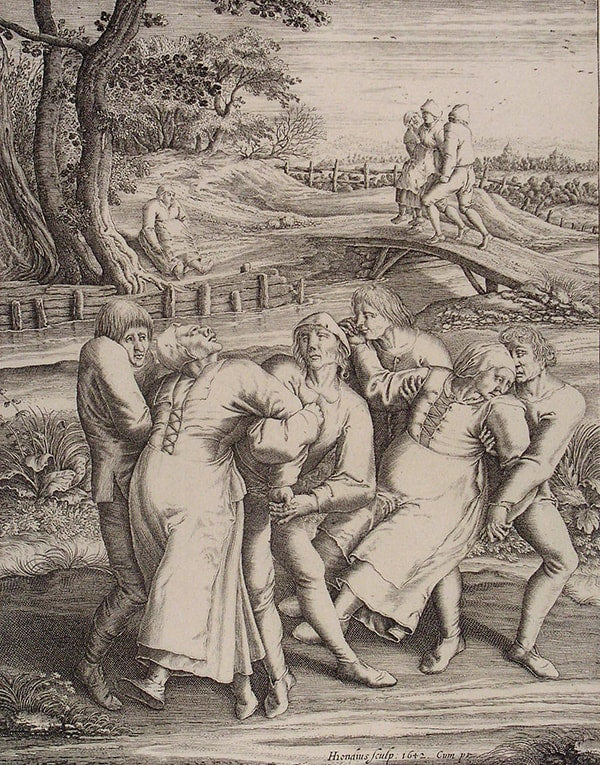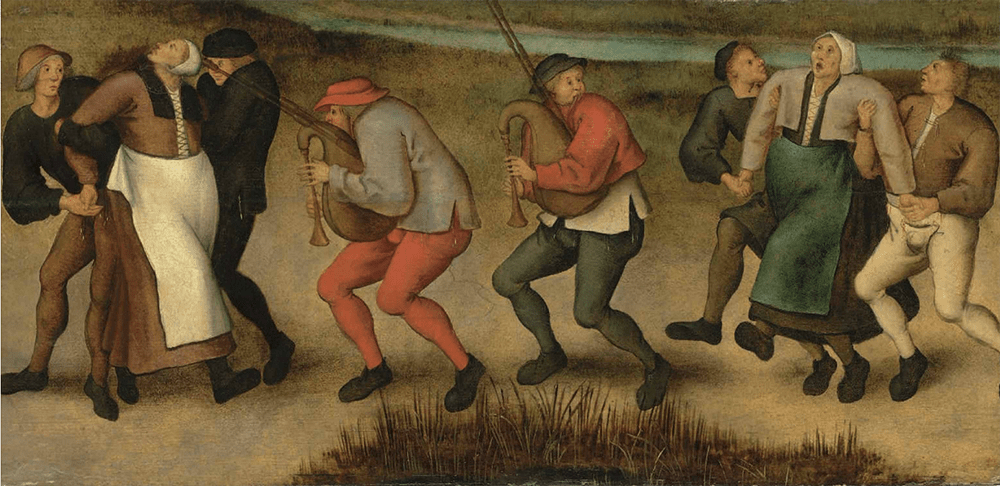During the 14th, 15th, and 16th centuries a few villains and events emerged that wouldn’t be out of place if you found them in episodes of TV’s American Horror Story. These evil-doers and strange occurrences were real and their existence has been substantiated in a variety of documents. In other words, it’s all true…well, most of it. Aspects of the legends that developed around these people and events have been misinterpreted over the years, facts have become mixed with myths, and some of the descriptions have become exaggerated. But most of the horrors actually occurred, and music was integral to each of these lurid tales.
The Legend of Dracula
The most familiar villain of the 15th century was probably Vlad III Dracula, Prince of Wallachia (a part of Romania), who lived from 1431 – 1476. By employing terror tactics, psychological warfare, and a small army, he contributed to stopping the Ottoman (Turkish) army when it invaded his native Wallachia. As a result, some Romanians today consider him a national hero for helping save Europe from the Turks, but others believe he’s a villain for using exceedingly cruel punishments during his reign. [1]
Dracula’s moniker “Vlad the Impaler” was derived from his preferred method for executing his victims: impaling them and displaying their heads on stakes. His reputation grew as the moniker became more popular, and the exceedingly fiendish punishments he imposed became better-known through the distribution of medieval Transylvanian pamphlets. Stories about Dracula were recorded in chronicles written after his death, and re-imagined more recently in Bram Stoker’s 1897 novel Dracula [2] as well as in 20th century movies. [3]
The prince’s legend grew, in large part, because of a widely-known 15th century song-poem written and set to music by a German poet named Michel Beheim (1416 – 1472) – a writer referred to as Germany’s most productive 15th century poet. Beheim’s song-poem, composed in 1463 and called “Story of a Bloodthirsty Madman Called Dracula of Wallachia,” detailed the ruler’s atrocities. It portrayed Dracula as someone who implemented acts of torture and mass murder and, according to some tales, was a madman who also drank blood. [4] The poem was first performed at the court of the Holy Roman Emperor Friedrich III during the winter of 1463 where Beheim sang his poetry to the accompaniment of various musical instruments.
Beheim’s “Dracula” poem was written in a manner similar but not identical to the German Meistergesang, a form of lyric poetry set to music and sung by a soloist. [5] Meisters (Masters) were highly skilled poets and tradesmen who could both write new verses to existing melodies as well as invent new melodies, and Meistersingers (Master singers) were members of the German guilds for lyric poetry, composition, and unaccompanied art songs. Each Meistersinger school had a system of learning intended to train trade apprentices and journeymen in the Meistergesang style, then promote them to the title of Meistersinger after an exam and the creation of a “masterwork.” [6] Some historians believe Beheim was a Meistersinger himself even though he didn’t belong to any of the Meistersinger guilds.
Establishing the context of Beheim’s poem is essential, given the political implications of the damage it would do to Vlad Dracula’s reputation. First of all, the Dracula poem shares many of the characteristics of Beheim’s other works, specifically a tendency to exaggerate numbers for political purposes, to invent conversations of which there is no record, even to manufacture incidents. For Beheim, historical accuracy was less important than adherence to the central principle that history is a vehicle shaped at will and intended to promote a particular political point of view.
Also, that these poems were performed raises the possibility of deliberate dramatization by an entertainer ever-conscious of the effect on his audience. Beheim had no direct contact with Dracula. For his narrative, he relied on three sources: earlier widely-circulating narratives, most of which are part of what is now called the St. Gall manuscript; current events such as Vlad’s arrest and imprisonment by King Matthias of Hungary, filtered through a political lens; and a first-hand account gleaned from a Catholic monk who had recently encountered Dracula in Transylvania and lived to tell his probably well-embellished tale. [7] The St. Gall manuscript (named after the Swiss monastery where it is located) comprises thirty-two short anecdotes, all of which present Dracula as a bloodthirsty tyrant.
Beheim uses the same parallel in his own poem, underscoring Dracula as a persecutor of the Church and hence the enemy of all mankind. Indeed, he uses the term “wutrich” (bloodthirsty monster) which he also employs elsewhere in his poetry.
By 1462, Vlad Dracula’s reputation as an exceptionally cruel and sadistic tyrant had been well established. That year, Pope Pius II sent a representative to investigate the recent arrest of Dracula by Matthias Corvinus, King of Hungary. The representative met Dracula in person, and has provided us with the only known description of the prince in a printed source. His report back to the Pope claimed that Dracula had [already] killed 40,000 of his political opponents by the most ferocious of methods, including impalement and skinning alive. Such tales were readily embraced, in fact even encouraged not only by Corvinus but by other opponents of Dracula in order to justify his arrest and imprisonment.
Beheim elaborates on the final statement in one of the St. Gall manuscript’s episodes, reporting it as follows: “It was his pleasure and gave him courage to see human blood flow and it was his custom to wash his hands in it as it was brought to the table.” [8]

Vlad the Impaler. Courtesy of Wikipedia/public domain.
The Strange Case of the Dancing Plagues
In addition to Dracula’s peculiar ways of entertaining himself, several bizarre events occurred when a mysterious affliction overwhelmed groups of men and women throughout Medieval and Renaissance Europe. Sometimes it affected only a few people, sometimes large masses, but the symptoms were always the same: uncontrollable, frenzied dancing which ended in physical collapse, exhaustion, and sometimes death. These outbreaks, usually referred to as choreomania, often incorporated music as a kind of therapy when “asymptomatic” people would use it to stop the affliction that troubled the dancers.
At an outbreak in the city of Strasbourg during the summer of 1518, between 50 and 400 people danced for weeks:
Citizens by the hundred[s] became compelled to dance, seemingly for no reason – jigging trance-like for days, until unconsciousness or, in some cases, death.
In full view of the public, this is the apogee of the choreomania that tormented Strasbourg. Also known as the “dancing plague,” it was the most fatal and best documented of the more than ten such contagions which had broken out along the Rhine and Moselle rivers since 1374. Numerous accounts of the bizarre events that unfolded that summer can be found scattered across various contemporary documents and chronicles compiled in the subsequent decades and centuries.
The more citizens this unusual plague afflicted, the more desperate the privy council became to control it. The clergy held it to be the work of a vengeful Saint Vitus, patron saint of dancers, entertainers, and neurological disorders, but the councilors listened instead to the guild of physicians, declaring the dance to be “a natural disease, which comes from overheated blood.” According to humoral [body fluids] theory, the afflicted must therefore be bled. But the physicians instead recommended the treatment given to past victims of this bizarre disease. They must dance themselves free of it. A 16th century chronicle composed by the architect Daniel Specklin records what the council did next. Carpenters and tanners were ordered to transform their guild halls into temporary dance floors, and “set up platforms in the horse market and in the grain market” in full view of the public. To keep the accursed in motion and so expedite their recovery, dozens of musicians were paid to play drums, fiddles, pipes, and horns, with healthy dancers brought in for further encouragement. The authorities hoped to create the optimal conditions for the dance to exhaust itself.
It backfired horribly. Being more inclined to a supernatural than a medical explanation of the dance, most of the onlookers saw in the frenzied movements a demonstration of the magnitude of Saint Vitus’ fury. None being free of sin, many were lured into the mania. [9]
The privy council ordered the stages to be pulled down. If the choreomaniacs must continue their disturbing movements then they now must do so out of sight. The council went further, prohibiting almost all dance and music in the city until September. This was no small thing for a culture in which communal dancing was central – from upright burghers performing their restrained, delicate steps…to ale-laden peasants leaping with hearty abandon to let off steam. Sebastian Brant, a Strasbourg chancellor and author of The Ship of Fools (1494), detailed the exception to the ban: “if honourable persons wish to dance at weddings or celebrations of first Mass in their houses, they may do so using stringed instruments, but they are on their conscience not to use tambourines and drums.” Presumably strings were deemed less likely than percussion to bring on the mania. [10]
Music and dancing had become dangerous, something to be kept at home, toned down, and performed only by “honorable persons.” Music lured people to the dance stages: Some people left without becoming affected, probably fascinated then appalled by the spectacle. For other people, music served as a “gateway drug” by hooking them into something beyond their control…something that was secondary to the awful and compelling sight of the dancers. And for those who did become entranced, music made the problem worse by helping to continue the spell. It was also suggested that dancing mania was similar to a “possession cult” – a trance initiated, sustained, and finally terminated by music.
Music was only one explanation for causing choreomania. 20th century investigators thought that the dancers might have eaten bread made from rye flour that had been contaminated with the fungal disease ergot which is known to produce convulsions. American sociologist Robert Bartholomew suggested that the dancers belonged to heretical sects, dancing to attract divine favor. The most widely accepted theory was medical historian John Waller’s who believed the dancing plague was a form of mass psychogenic disorder. He claimed such outbreaks take place under circumstances of extreme stress and generally reflect local fears.
According to Waller, the Strasbourg poor were primed for an epidemic of hysterical dancing. First of all, there was precedent. Every European dancing plague between 1374 and 1518 had occurred near Strasbourg, along the western edge of the Holy Roman Empire. Then there were the prevailing conditions. In 1518, a string of bad harvests, political instability, and the arrival of syphilis had induced anguish extreme even by early modern standards. This suffering manifested as hysterical dancing because the citizens believed it could. People can be extraordinarily suggestible and a firm conviction in the vengefulness of Saint Vitus was enough for it to be visited upon them. “The minds of the choreomaniacs were drawn inwards,” writes Waller, “tossed about on the violent seas of their deepest fears.” [11]
The Strasbourg plague is the most famous example of choreomania. Similar events included an outbreak during the 11th century in Kölbigk, Saxony where it was believed to be the cause of demonic possession or divine judgment. In 15th century Apulia, Italy a woman was bitten by a tarantula, the venom making her dance convulsively (and cause later composers to write “Tarantella” dance music, no doubt). The only way to cure the bite was to “shimmy” and have the right sort of music available, which was an accepted remedy by some scholars.
As for Strasbourg, whatever the cause, the mania lasted for about two months before ending as mysteriously as it began. And like Dracula’s legend, tales of the choreomaniacs have been frightening people for centuries beyond their occurrences.
Some Words of Caution
Halloween is just about here, so I suggest staying home where it’s safe. If you do go out, avoid listening to any rock band called Dracula and the Choreomaniacs. Avoid any gathering hosted by someone named Vlad III, and decline all offers of food made from rye flour. Finally, if you’re invited to a party where the guests seem to be moving in an uncontrollable manner, focus your attention, keep your head, cover your ears, and dance The Mashed Potato in order to gyrate your way as quickly as possible out the door.
Suggested Listening
The Black Dragon: Music from the Time of Vlad Dracula
[1] The research is interesting because of the different ways it has been used, and reasons why people have chosen to view Vlad as a hero or villain. These descriptions may be two sides of the same coin, i.e., heroes are capable of deeds of compassion or cruelty, of humanity or inhumanity, or of good or of evil.
[2] Although it seems likely Stoker knew about Vlad the Impaler, there’s some controversy concerning whether or not Stoker actually used Vlad as a model for his vampire.
[3] Some of the best Dracula films were produced by the British Hammer studios during the late1950s – 1970s. Kevin Lyons of the British Film Institute noted: “A post-millennial revival [of Hammer movies] has yielded a handful of interesting films, but none can hold a candle to those 18 years when the Hammer name promised an hour and a half of gory, sexy and inventive thrills.” (May 2, 2017)
[4] Dracula supposedly washed his hands in blood, likely misinterpreted as drinking blood. Over time, this and other elements of the legend might have been influenced by the story of Elizabeth Bathory (1560 – 1614), the serial killer “Blood Countess” accused of bathing in the blood of her servants to keep herself eternally young.
[5] The form developed at the end of the 14th century and reached its height in the 16th century.
[6] These singers held regular competitions to display their skills and name new Master singers. Richard Wagner’s opera Die Meistersinger von Nürnberg (1868) presents exactly such a contest: In the opera, the winner will not only be crowned Master but will also receive prizes including the goldsmith’s beautiful daughter.
[7] Many people who made contact with Dracula, even if they weren’t his enemies, were tortured or disposed of by Vlad and didn’t live to tell their tales.
[8] Excerpts from David B. Dickens and Elizabeth Miller, “Michel Beheim, German Meistergesang, and Dracula,” Journal of Dracula Studies: Vol. 5, Article 5, 2003.
[9] “The authorities turned a crisis into a nightmare scenario worthy of a canvas by Hieronymus Bosch.” John Waller, The Lancet, February 21, 2009.
[10] “Stringed instruments weren’t considered as dangerous because percussion triggered the spasmodic, rhythmic convulsions of the dancing.” Excerpts from Ned Pennant-Rea, “The Dancing Plague of 1518,” The Public Domain Review, July 10, 2018.
[11] Ibid.

Courtesy of Wikimedia Commons/Hendrik Hondius/public domain.
Header image courtesy of Wikimedia Commons/Pieter Bruegel/public domain.



